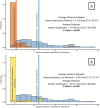Genetic Network Analysis to Assess the Risk of Human Immunodeficiency Virus Transmission Among Men Who Have Sex With Men Seeking Partners on the Internet
- PMID: 30953067
- PMCID: PMC7319271
- DOI: 10.1093/cid/ciz278
Genetic Network Analysis to Assess the Risk of Human Immunodeficiency Virus Transmission Among Men Who Have Sex With Men Seeking Partners on the Internet
Abstract
Background: Online partner seeking (OPS) among men who have sex with men (MSM) is associated with increased risk behavior including frequency of unprotected anal intercourse, number of partners, and incidence of sexually transmitted infections (STIs). However, the impact on transmission of human immunodeficiency virus (HIV) is uncertain.
Methods: MSM diagnosed with acute and early HIV infection were recruited from the Primary Infection Resource Consortium. HIV transmission events in the year following infection were inferred using estimated date of infection combined with genetic network analysis with linked sequences defined as ≤0.015 sequences/site difference in the HIV type 1 (HIV-1) pol coding region. Participants completed a detailed baseline questionnaire including reported methods of meeting sexual partners, including OPS, in the prior 3 months, and regression was performed with inferred transmission as the outcome.
Results: From 147 MSM who completed the questionnaire, there were an associated 20 inferred HIV transmissions. No association with OPS was found (odds ratio, 0.64 [95% confidence interval, .24-1.69]; P = .37), though individuals who reported OPS were more likely to have reported a greater number of partners (P = .003) and prior STIs (P = .002). Geospatial analysis did not indicate that OPS was associated with increased geographical reach of the user (P = .68).
Conclusions: Individuals reporting OPS did not have increased odds of inferred HIV-1 transmission in the year following infection using genetic linkage analysis despite apparently increased risk behavior. OPS also did not increase the geographic distance between genetically clustered HIV infections, suggesting that individuals mainly use the internet to meet partners in their local region.
Keywords: HIV; MSM; internet; online partner seeking; transmission network.
© The Author(s) 2019. Published by Oxford University Press for the Infectious Diseases Society of America. All rights reserved. For permissions, e-mail: journals.permissions@oup.com.
Figures



References
-
- Centers for Disease Control and Prevention (CDC). HIV surveillance report. Atlanta, GA: CDC, 2017:29.
-
- Macdonald N, Elam G, Hickson F, et al. . Factors associated with HIV seroconversion in gay men in England at the start of the 21st century. Sex Transm Infect 2008; 84:8–13. - PubMed

